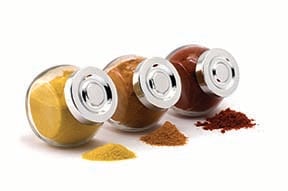 Sudan dyes are red dyes that are used in a variety of textiles, rubber, plastics, solvents, oils and shoe and floor polishes. In most countries, the dyes have been banned, but they are still found in a variety foods. In 2005, the dyes were found in more than 500 foods, including brands of Worcestershire sauces, fast-food dressings, potato chips and prepared soups. Manufacturers use the dyes to enhance and maintain the color of their food products. In August 2015, the Ghanaian Food and Drug Authority (FDA) investigated a palm oil product that contained Sudan Dye IV. The product was exported to the United Kingdom. In October, the FDA issued a warning about the Sudan dye in palm oil sold in Ghana and began to remove the product from store shelves.
Sudan dyes are red dyes that are used in a variety of textiles, rubber, plastics, solvents, oils and shoe and floor polishes. In most countries, the dyes have been banned, but they are still found in a variety foods. In 2005, the dyes were found in more than 500 foods, including brands of Worcestershire sauces, fast-food dressings, potato chips and prepared soups. Manufacturers use the dyes to enhance and maintain the color of their food products. In August 2015, the Ghanaian Food and Drug Authority (FDA) investigated a palm oil product that contained Sudan Dye IV. The product was exported to the United Kingdom. In October, the FDA issued a warning about the Sudan dye in palm oil sold in Ghana and began to remove the product from store shelves.
The Sudan dyes are part of the compound group named Azo-dyes, which have been listed by the International Agency for Research on Cancer as a carcinogen. The European Union and the United States have banned the use of these dyes in foods and spices.
Teledyne Tekemar recently put its automated QuEChERS extraction method to the test using its AutoMate-Q40 to determine levels of Sudan dyes in food. Researchers used liquid chromatography coupled with triple-quadruple mass spectrometry to detect Sudan dyes in agricultural commodities. The quantification was based on matrix-matched calibration curves for each commodity. The automated extraction streamlines the QuEChERS Method while providing suitable analytical results falling in the method for all target compounds.
Sudan dyes I, II, III and IV were purchased neat from Sigma Aldrich. A standard solution of 1,000 mg/mL of each dye was prepared in Acetonitrile. From these four stock solutions a 40 mg/mL standard solution was prepared fresh daily in Acetonitrile. The sample analyzed for this application was a non-contaminated organic chili powder purchased from an Ohio market.
The sample was prepared by depositing two grams of the organic chili powder into a 50 mL centrifuge tube, which was placed inside the AutoMate-Q40. The AutoMate-Q40 added 10 mL of both water and 1% HOAc in Acetonitrile to the sample, which was then vortexed for 30 seconds. Once the vortex was complete the unit added the Tek-Q AOAC QuEChERS Salts. The sample was shaken for 1 minute, and then placed into the centrifuge for 1 minute. The AutoMate-Q40 removed a 6 mL aliquot from the liquid solid extraction and transferred it into the Tek-Q dSPE tube (900 mg MgSO4 and 150 mg PSA). The dSPE was shaken and centrifuged for 1 minute each. The Automate-Q40 then removed 4 mL from the dSPE tube and placed the aliquot into the final extract tube.
The automated QuEChERS extraction performed using the AutoMate-Q40 is a suitable method for extracting illegal dyes from chili products. Precision and accuracy were assessed for the chili powder analyzed. Automating the extraction with the AutoMate-Q40 for chili powder allowed for easy, reliable and highly reproducible extractions.
The AutoMate Q40 automates the liquid handling, addition of salt.buffers, sample mixing, pipetting and liquid-level sensing using a patent-pending VialVision. The system frees scientists from labor-intensive extraction methods and any exposure to harmful chemicals. It improves repeatability, reduces likelihood of human error and offers potential for significant labor savings.
For details about the instrumentation and analytical conditions, as well as the study results, download the Application Note
